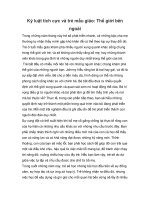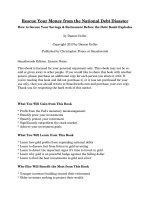THE ASSERTIVENESS POCKET BOOK pot
Bạn đang xem bản rút gọn của tài liệu. Xem và tải ngay bản đầy đủ của tài liệu tại đây (838.63 KB, 113 trang )
THE
ASSERTIVENESS
POCKETBOOK
By Max A. Eggert
Drawings by Phil Hailstone
Dedication
This book is dedicated to my son, Max Charles, who, in spite of my influence, is very much his own man
and, for one so young, has developed his own way of being assertive. Max, I’m proud of you.
Thanks to Donna Coiera for transforming my handwriting into an acceptable WP format.
“Will appeal to anyone in human resources or management training. It is successful in keeping
jargon to a minimum without loss of precision. The concepts are immediately relevant, and
each page will offer you a new idea, a new skill or a new way to look at a situation.”
Louise Campbell, Associate Director, Human Resources, Societe Generale Australia Ltd.
“This pocketbook provides at a glance the skills required for a lifetime.”
Tracey Luscombe, Human Resource Manager, Manchester Unity Friendly Society in NSW.
CONTENTS
INTRODUCTION 1
Definition, popularity, with whom can
you be assertive, why now, when to use
it, assertiveness and integrity, keeping a
balance
THREE BEHAVIOUR TYPES 9
Three options, non-assertive behaviour
(reasons, mind games, musts and
obligations, self talk, inner voices),
aggressive behaviour, assertive
behaviour (advantages, liberation
circle, affirmations)
RIGHTS & RESPONSIBILITIES 35
Definitions of basic assertive rights,
corresponding responsibilities, rights
and responsibilities at work
ASSERTIVENESS SKILLS 53
Body language, receiving and giving
criticism, receiving positive feedback,
disagreement process, ‘I’ statements,
asking for what you want, broken record,
negative assertion, fogging, negative
enquiry, power words
ASSERTIVE ACTIVITIES 91
General advice points, ten activities to
practise assertive behaviour
INTRODUCTION
1
ASSERTIVENESS
Enjoying your rights
Expressing your feelings
Asking for what you want
Stating your views
WITH
integrity
honesty
directness
respect for others
INTRODUCTION
DEFINITION OF ASSERTIVENESS
Assertive: (adj) confident and direct in dealing with others.
Collins Concise English Dictionary
Assertiveness is upholding one’s own integrity and dignity whilst at the same time
encouraging and recognising this behaviour in others.
2
INTRODUCTION
INCREASING POPULARITY
Assertiveness and the skills associated with it are increasing in popularity because:
● There has been an increase in individual freedom
● It empowers people who use it
● It encourages psychological health in those who use it
● In less hierarchical work structures, managing by rank alone is no longer effective
● More competition for resources makes it necessary for individuals to pursue
what they want
3
YOU
Your clients
Yourself
Your family
Your friends
Your network Your colleagues
Your team
Your managers
Your subordinates
INTRODUCTION
WITH WHOM CAN YOU BE ASSERTIVE?
In fact, assertiveness is useful for everyone with whom you come into contact.
4
INTRODUCTION
WHY ASSERTIVENESS NOW?
● Social and political hierarchies based on birth or caste are no longer successful
within capitalist structures
● Successful enterprises are based on meritocracy and need everyone to achieve their best
● To be successful, society requires all to make a contribution - no one person is
inherently better than another
● To speak one’s mind and to reveal one’s true position have been found to engender
psychological health and improved relationships
● At work the person doing the job is the one who can make the most significant
contribution to improvements on the job
● The political value and power behind the equality movement for gender, race, religion,
colour and ethnic origin are now integrated into the culture of western civilisation
● The full fruition of democratic principles of individual freedom, and the equal rights of
all within society, encourage all to pursue their rights and aims
● The New Age philosophy of individual empowerment and pursuit of personal
excellence encourages people to be themselves
5
In the face
of criticism
When you
want something
When you
want to negotiate
When you don't
want something
When you want
to give feedback
When you
are hurt
When you
are happy
When you
are angry
YOU
INTRODUCTION
WHEN TO USE ASSERTIVENESS
6
WITH SELF WITH OTHERS
What you feel
What you think
What you need
Their impact on you
Their behaviour
What you want from them
HONESTY
INTRODUCTION
ASSERTIVENESS AND INTEGRITY
When we are assertive we increase our integrity because we are honest with ourselves
and with others.
When we are honest with ourselves and with others we are able to achieve what we want
without compromise.
7
NEEDS OF OTHERS
OUR NEEDS
NEEDS OF OTHERS
OUR NEEDS
NON ASSERTIVE ASSERTIVE AGGRESSIVE
INTRODUCTION
KEEPING A BALANCE
In assertiveness we balance the needs of others with our own. We treat others as we
wish to be treated. When necessary we can choose whether to give priority to the needs
of others or choose to give greater consideration to our own needs.
WEAK : When we put all the needs of others before our own
AGGRESSIVE : When we put personal needs before those of others
ASSERTIVE : When we balance our needs and those of others and act
according to the priorities as we see them
8
THREE BEHAVIOUR TYPES
9
THREE BEHAVIOUR TYPES
THE THREE OPTIONS
When faced with difficult situations animals have two options:
FLIGHT = non-assertion
FIGHT = aggression.
Humankind has a third option: ASSERTIVENESS, which is essentially a considered
response to difficult situations.
Let us look at these three options:
● Non-assertion
● Aggression
● Assertiveness
so that we can recognise them in ourselves and be able to manage them constructively.
10
THREE BEHAVIOUR TYPES
1. NON-ASSERTIVE BEHAVIOUR
The non-assertive person:
● Is reluctant to express own opinions, and particularly, feelings
● Often feels used by others
● Keeps quiet when others take advantage
● Refrains from complaining when services or products
are not up to standard
● Finds it difficult to refuse the requests of others for
time or resources
● Acquiesces in the views and desires of the majority
even though these conflict with personal wishes
● Frequently makes compromises in the interests
of harmony
● Is unwilling to inconvenience people for the things
he or she wants
● Is submissive in the presence of aggressive behaviour
● Prefers to keep own views private
11
THREE BEHAVIOUR TYPES
1. NON-ASSERTIVE BEHAVIOUR
OUR REASONS
Fear of upsetting others
There is a myth in interpersonal relations that goes like this. If you sacrifice enough, work
hard enough, care enough, forgive enough, other people will give you their approval.
It gets worse. If you don’t gain their approval it is because you are not giving up enough,
working hard enough, caring enough, etc.
● You can choose to change your behaviour if you think that the cost of losing
someone’s friendship is higher than doing or saying what you want; but it is indeed
rare for anything to be that significant
● What you are is something absolute, and independent of the goodwill of others;
what others think of you does not make you any more or any less of what you are
● People usually want you to change your behaviour when they don’t get exactly what
they want; even if they think ill of you, what you know yourself to be does not change
12
THREE BEHAVIOUR TYPES
1. NON-ASSERTIVE BEHAVIOUR
OUR REASONS
Fear of rejection
This is the extreme version of fear of upsetting others. If we upset someone by asking
for what we want, we fear they will withdraw their regard for us and reject us altogether.
● In any relationship there has to be give and take, but if it is all ‘take’, then the
relationship is essentially flawed at a basic level, and the price is too high for any
individual to pay
● Usually, a moment’s reflection is enough to make you realise that:
a) if they say no, they are unlikely to reject you personally, and
b) if they do want to reject you then the price of their friendship is too
high anyway
13
THREE BEHAVIOUR TYPES
1. NON-ASSERTIVE BEHAVIOUR
OUR REASONS
Feeling responsible for the other person
There is a real difference between hurting someone and someone feeling hurt. You are
not responsible for their feelings; if they ‘feel’ hurt because of a reasonable need that
you have, then that is their choice.
This is totally different from a situation where, through aggressive behaviour, you hurt
someone by abusing their rights, taking deliberate advantage or by not respecting them
as a person.
Inappropriate inner voices
This occurs when the rules by which we live have been determined by others, usually
during childhood, and we still operate by them. (See page 22 for further thoughts on this.)
14
THREE BEHAVIOUR TYPES
1. NON-ASSERTIVE BEHAVIOUR
SELF-DEFEATING MIND GAMES
Someone once said that there are two realities - the way we think things are, and the way they
really are. The way we think about ourselves and our experience can very much affect us and
our behaviour. If our perceptions are our reality we must be very careful not to play self-
defeating mind games. We must be aware of what psychologists call ‘cognitive distortions’,
that is the way the mind lays an inappropriate explanation over a neutral experience.
NEUTRAL FACTS + EMOTIONAL INTERPRETATION = DISTORTED REALITY
Here are the more common games
we play to defeat ourselves:
G GENERALISATION
D DOOMSDAYING
L LABELLING
MR MIND READING
F FILTERING
P PERSONALISING
We examine them in turn.
15
G
D
L
MR
F
P
THREE BEHAVIOUR TYPES
1. NON-ASSERTIVE BEHAVIOUR
SELF-DEFEATING MIND GAMES
Generalisation
This is taking one event and thinking it will always occur.
‘I failed once therefore I always fail’, or
‘I did not get it right first time so I will never get it right’.
This takes us back to ‘if you think you can or you
think you can’t, you’re right’. You get what you expect.
Your life becomes a self-fulfilling prophecy of failure.
Most upsets in life are ‘small stuff’.
Doomsdaying
This is magnifying something, typically blowing up a small
failure out of all proportion, as if it will bring about the
end of the world. The normal ups and downs of
everyday life become a series of huge tragedies and
dramas which compound feelings of personal failure.
16
G
D
THREE BEHAVIOUR TYPES
1. NON-ASSERTIVE BEHAVIOUR
SELF-DEFEATING MIND GAMES
Labelling
When you hang a large sign around your neck which says ‘hopeless’, or ‘lazy’ or
‘friendless’ then you are labelling yourself. When an opportunity occurs for you to do
something, you look down at your label and act accordingly. Like Daffy Duck, if you
have a label that says ‘No one loves me’ around your neck, and you keep saying it to
yourself, it quickly becomes reality.
Mind reading
You smile at a friend at a party and they ignore you; immediately you think they don’t
like you or you have upset them. This is because you can read minds, and just by
looking at them you can tell exactly what they think. The fact that they are short-sighted,
or thinking hard about something, or even a little intoxicated is neither here nor there.
People do things for a whole host of reasons and it is self-defeating to ‘mind read’ into
their behaviour a negative attitude towards yourself.
17
L
MR
THREE BEHAVIOUR TYPES
1. NON-ASSERTIVE BEHAVIOUR
SELF-DEFEATING MIND GAMES
Filtering
Filters do a great job of taking out unwanted material, but in the case of a personal filter
it removes all the positive things that occur in your life. Rather like the reverse of rose-
tinted glasses, people who filter only accept bad news about themselves and their
situations. Thus confirming their view of the world.
Personalising
When you personalise, you take full personal responsibility for a mishap or difficulty.
Events occur for a whole host of reasons, but you take full personal responsibility even if
your part was minor.
You can always do more, try harder, be more persistent, but you can’t control or be the
cause of everything. If you continually personalise the events in your life you will be
condemned to a life of everlasting doubt, guilt, blame and self-denigration.
18
F
P
I must gain happiness
through service to
others because
I must be good
and kind because
I must not hurt
anybody because
I must agree to reasonable
requests because
I must respect my elders
and my betters because
I must do as I'm told
or what is expected
of me because
THREE BEHAVIOUR TYPES
1. NON-ASSERTIVE BEHAVIOUR
THE TYRANNY CIRCLE OF MUSTS
Non-assertive persons are imprisoned by ‘musts’ in their head.
19
THREE BEHAVIOUR TYPES
1. NON-ASSERTIVE BEHAVIOUR
THE PRISON BARS OF INAPPROPRIATE OBLIGATION
Freedom and assertiveness are about choosing the rules you wish to live by.
20
NEGATIVE THOUGHTS
ABOUT SELF
ACTUAL
PERSONAL
FAILURE
LOW SELF-
ESTEEM
EXPECTATIONS
TO FAIL
HIGH SELF-
ESTEEM
POSITIVE THOUGHTS
ABOUT SELF
EXPECTATIONS
TO SUCCEED
ACTUAL
PERSONAL
SUCCESS
THREE BEHAVIOUR TYPES
1. NON-ASSERTIVE BEHAVIOUR
SELF TALK: FAILURE AND SUCCESS CIRCLES
21
“If you think
you can or you think you can’t
you’re right”
Henry Ford
THREE BEHAVIOUR TYPES
1. NON-ASSERTIVE BEHAVIOUR
THE TYRANNY OF INNER VOICES
Sometimes the way we talk to ourselves works against us. We all have voices in our
heads that monitor what we do and how we behave. Sometimes the voices are our own;
sometimes they are voices of people significant in our past: parents or teachers, in fact
anyone in our childhood who was emotionally significant. Sometimes the voices are
helpful, sometimes not. Whilst it may be difficult to stop the voices, even when you know
it is your mother speaking, you can decide whether or not to be influenced. Here are
some of the more inappropriate voices:
● Don’t make a fuss
● Always respect your elders and betters
● You must always work hard
● Real men don’t cry
● A good woman is always patient
● All’s well that ends well
● Don’t bring your problems home
● You must work harder
22
● Life is not supposed to be fun
● Be good
● Children should be seen and not heard
● Don’t interrupt
● Grin and bear it
● Be perfect
● Finish what you start









